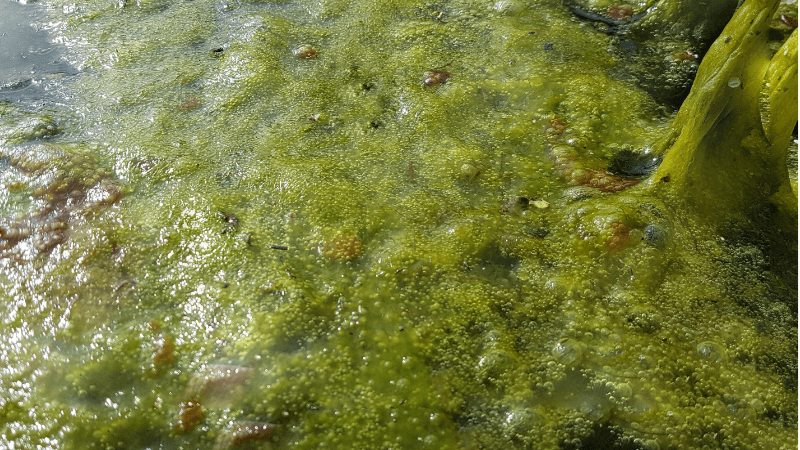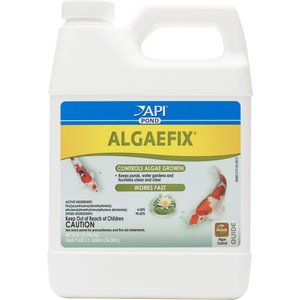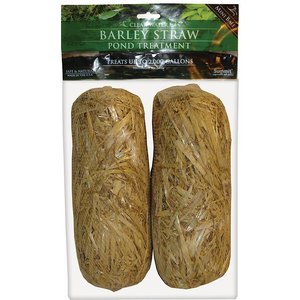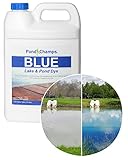What Is Pond Scum? (Plus, How to Get Rid of Pond Scum for Good)
Pond Academy is reader-supported. Buying through links on our site may earn us an affiliate commission. As an Amazon Associate I earn from qualifying purchases.
Pond scum is more than just an insult hurled at somebody…
Or a delicious mixed drink you can find at the bar.
It's actually more commonly known as a slimy green nuisance for pond owners.
But what exactly is pond scum? And what causes it to take over ponds? And more importantly, how the h-e-double hockey sticks does one get rid of it?
We take a deep dive into exactly those questions (and more) in this definitive guide to pond scum!
What Is Pond Scum?

Pond scum is a fact of life for most pond owners.
But what many don't realize is the very definition of “pond scum” is ambiguous.
Some pond owners use the term “pond scum” to define any unwanted mass of floating pond weeds or debris. And while the aforementioned can be a real nuisance, it's not necessarily pond scum.
So, what exactly is pond scum then? Strictly speaking, pond scum refers to filamentous algae that have grown in densely interwoven mats across a pond's surface.
Scientific names of pond scum include Cladophora, Pithophora, and Spirogyra.
Before becoming pond scum, these algae develop on the pond's rocky bottom or sides. As they grow, they produce oxygen, which renders them buoyant and allows them to float to the water's surface. Under normal circumstances, a pond with a diverse and healthy ecosystem can process these algae before they cover the surface too densely. When filamentous algae grow particularly aggressively, though, they can quickly overwhelm a pond's surface, to the detriment of both the pond's appearance and its ecosystem.
Get Our Best Pond Tips Sent to Your Inbox for Free!
Join thousands of others and learn from our decades of pond building and maintenance experience! Your pond will thank you!
By subscribing you agree to receive emails from PondAcademy.com. We will always respect your privacy and you can unsubscribe at any time.
What Causes Pond Scum?
Filamentous algae, aka pond scum, can overwhelm a pond when given the right mixture of:
- High levels of nutrients
- Daylight
- Warm temperatures
The above can lead to an abundance of natural scum in many farm and wild ponds since they are not usually managed.
Smaller backyard ponds can experience the same problem, but in this case, it's usually due to mismanagement of the pond. Undersized and poorly maintained pond filters, leftover fish food, and excess debris (leaves, for example) in the pond can easily fuel algae blooms when temperatures rise.
How to Get Rid of Pond Scum
Step 1: Identify Cause of Pond Scum
Because the very definition of pond scum is sometimes unclear, and the possible reasons for filamentous algae blooms are so many, the first step toward clearing the scum is an accurate diagnosis.
Specifically, you should identify the source of the excess nutrients feeding the scum. Without a proper diagnosis of the underlying cause, even a successful treatment of one season's pond scum will likely do nothing to prevent another bloom.
![]() Did you know...
Did you know...
You'll never get rid of ALL the algae in your pond. Even the filamentous varieties that can be especially problematic are present in nearly all forms of water. Rather, you'll want to focus on limiting filamentous algae to beneficial levels by controlling nutrient levels.
Nutrients used by filamentous algae can come from many sources, including the following:
Fertilizers
Many ponds receive water from external sources. For example, rain can lead to water running downhill into your pond. Even lined ponds are susceptible: pond liners may develop tears or leaks over time.
Be sure you aren't using any fertilizer treatments near your pond and that water run-off doesn't enter your pond.
Fish Waste
Fish are popular additions to ponds and can be vital parts of thriving pond ecosystems. Most pond owners supplement their fish's natural diet with supplemental food, unused bits that can drive algae growth. This problem is not always due to overfeeding: low-quality fish food may be incompletely digested, leaving more nutrients for algae even when every bit of food was originally consumed as intended.
Be sure to use quality fish food and give them just enough food that they won't leave any behind.
New Ponds
Mature ponds contain various organisms, including ones smaller than algae itself. Beneficial bacteria, for example, naturally consume the same nutrients used by algae. When they are present in healthy quantities, bacteria compete with algae for nutrients leftover by larger organisms.
However, newly built ponds introduce algae as soon as they are filled with water…but contain little to no beneficial bacteria. To make matters worse, sunlight readily penetrates the clear water of new ponds. With less competition for resources, algae bloom more easily and aggressively.
When filling your pond with water for the first time (or even if you had to drain your pond for some reason and refill it), it's important to fill it properly.
If you use regular tap water, you'll want to make sure you treat the water, especially if you have fish and other pond life. The high levels of chlorine and chloramine in tap water will wreak havoc on the bacteria levels and can even hurt your pond life, so it's a good idea to use a pond dechlorinator.
And for a little peace of mind and to jump-start the growth of good bacteria, I recommend adding in some beneficial bacteria. This will help promote a healthy pond ecosystem as quickly as possible.
Step 2: Pond Scum Removal
Once you've identified (and fixed) the reason your water is experiencing an excessive amount of green pond scum, it's time to remove it. There are two main ways to effectively rid your pond water of scum.
Manual Removal
Raking mats of filamentous algae from the surface of the water or capturing them in nets is the safest way to get rid of floating pond scum, but also the more labor-intensive way.
Along with the algae, manual approaches also remove some of the nutrients that drive new algae growth, providing some preventive benefits. For the same reason, algae mats should not be disposed of near the water's edge; this prevents nutrients from leaching back into the pond. In other words, don't just remove the algae and throw it next to your pond. You'd be surprised how often this is done by pond owners trying to get rid of green pond scum.
Once larger chunks of the algae mat have been removed with a rake, it is a good idea to use a pond vacuum to suck up any of the smaller algae strings. This will help prevent them from growing back quicker.
Manual removal is often used with chemical methods, which leads us to…
Chemical Removal
Pond algaecide is a special kind of herbicide that targets the cellular walls of algae without affecting other organisms (when used appropriately).
This direct approach means that chemical algae killers are best used when algae begin to bloom and when both nutrient levels and water temperature encourage aggressive algae growth. When algaecide is applied properly, algae will slowly die, leaving a layer of dead algae and muck. This layer must be manually removed using a rake (check out our homemade pond rake) or net (see above).
Algaecides are highly effective as long as they are used wisely. Here are a few best practices for using chemicals in your pond.
Treat the water deliberately. Heavy concentrations of algaecide can affect fish and other organisms. No more than 50% of a pond's surface should be treated at a given time; this goes for even the smallest ponds. When algae are already blooming, no more than 25% of a pond should be treated at once. Most algae-killing chemicals recommend waiting two weeks between applications; doing so increases the algaecide's effectiveness and reduces the stress placed on other aquatic life.
Remove dead material promptly. Layers of dead algae can create problems of their own while perpetuating some of the negative biological effects of pond scum. And they sure don't look any better. Pond owners should rake away dead algae as it accumulates (and remember, don't throw it next to your pond).
Step 3: Preventing Scum From Returning
Removing pond scum only addresses the results of the latest algae bloom. These pond algae control measures will help ensure the scum doesn't return.
Barley Straw
Barley straw does nothing at first to control algae. As it decomposes, though, it produces humic acid, which reacts with surface water to generate hydrogen peroxide. In the process, oxygen that had previously been available in the pond's water is bound to hydrogen molecules, creating a compound unusable by algae. Or by fish. Because it controls algae by reducing the amount of dissolved oxygen in the pond's water, it can create problems in ponds and lakes stocked heavily with fish and other aquatic animals. In larger, less populated ponds, it removes just enough dissolved oxygen to slow algae growth without affecting other organisms.
Pond Plants
Plants are staunch competitors with algae for sunlight and nutrients, limiting algae's ability to bloom. They also provide consistent food sources and hiding places for the fish and small invertebrates that form important parts of most ponds' ecosystems.
Oxygenating pond plants have the added benefit of releasing oxygen into the water, which will help fish and other pond life survive and thrive.
Pond Dyes
Ponds that do not support fully submerged plants can use a UV-filtering dye to block sunlight from reaching algae where it develops: on the pond's floor.
Dyes are effective at preventing large blooms of algae but won't do much good for removing an existing bloom unless combined with a manual or chemical removal method, as discussed in Step 2.
When used as recommended, they are safe for aquatic life, including most pond plants. Check out our reviews and comparisons of the best pond dye products on the market today for more detailed information.
Pond Snails
Most pond snails are capable of eating algae; some, like the Japanese Trapdoor Snail, choose it as one of their primary foods.
Snails are good choices to help control established growths of algae but should be introduced with care. They reproduce rapidly and will gladly turn to other aquatic plants, even beneficial ones, if algae levels are insufficient.
Algae-Eating Fish
Some fish include algae in their diets. The Common Pleco, for example, is a popular pond algae eater that scours rocky surfaces for small invertebrates, bits of food, and best of all - algae! The Siamese Algae Eater is another voracious algae eater that loves to eat it in all forms - from scum to even red algae.
Algae-eating fish tend to be naturally unpicky eaters. Still, some pond owners choose to feed fish manually to complement a pond's natural resources, especially when fish have been recently introduced. Care should be taken not to feed fish more than they can eat in a few minutes: any uneaten food quickly falls to the pond's floor, where its nutrients are perfect engines for rapid algae growth.















